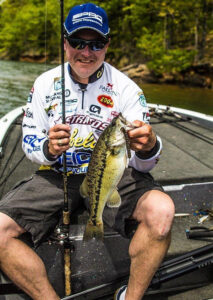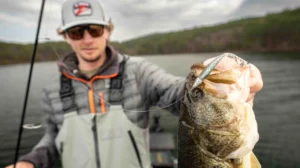Carolina rig fishing has received an unfair reputation over the years as being a boring, do-nothing technique for bass fishing. When the bass are done spawning and begin moving to offshore cover and structure for the summer, a Carolina rig is actually one of the most productive ways to catch these sluggish fish.
According to Zoom pro Mike McClelland, there isn’t anything boring about a Carolina rig. When he’s faced with finicky bass and warm water temperatures, you can bet he’ll have his trusty Carolina rig within reach.
Use a Carolina rig to find the sweet spot
With the recent introductions of Side Scan, Down Scan, GPS and contour mapping, many anglers overlook the effectiveness of the Carolina rig for finding productive bass fishing waters. Although McClelland is a big believer in his Lowrance electronics, he continues to rely on a Carolina rig to locate key areas that hold big bass.
“My electronics are awesome, but there’s just something different when you can feel the crunchiness of rocks and gravel with a C-rig,” McClelland said. “Once you feel your rig cross over a rough spot or irregularity, it gives you a great grasp of how the cover or structure is laid out and lets you get really dialed in with a solid reference point. I believe a Carolina rig is one of the best ways to learn what’s really on the bottom of your favorite lake.”
Cover water with it when the fish won’t eat a crankbait
Just because the Carolina rig is a different technique to present soft plastic baits, don’t push it aside when you need to cover water. Its design allows you to cover large areas in a much shorter period of time than many traditional soft plastic presentations.
“If you’re just looking for fish in the summer, it’s hard to beat a Carolina rig,” McClelland said. “Whether you’re fishing big points, long stretches of ledges or even humps, you can cover them very quickly without burning much time. You can throw around it, on top of it, to the sides—the possibilities are infinite.”
Whenever a deep crankbait bite dies for McClelland, he also uses the Carolina rig as a follow-up bait. There have been many instances in which he’s reignited a school of bass by throwing a Carolina rig to them.
“Often times a crankbait may just catch the most aggressive fish in a particular school,” McClelland said. “After you catch a bunch of smaller ones and the bite dies, you can start catching the big ones on a Carolina rig. It’s something slower and more subtle than a crankbait, but it’s much more efficient than a traditional Texas rig.”
Get creative with your soft plastic selection
One of the great things about a Carolina rig is its versatility. Don’t get discouraged if you don’t have a huge repertoire of soft plastic baits, because according to McClelland, you can catch fish on just about any type of soft plastic.
Despite the Carolina rig’s versatility, McClelland has narrowed down his soft plastic selection to a few specific shapes. If he’s looking to cover water and simply generate bites in an area he’s not yet familiar with, he uses a Zoom Fish Doctor or Zoom Centipede due to their small profiles and subtle actions. When it’s tournament time, however, and he’s on the hunt for giant bass, he relies heavily on a Zoom Lizard and Zoom Brush Hog. He keeps his color selection fairly simple in every situation.
“In clear water on a bright, sunny day, I’m more apt to use watermelon colors, such as watermelon purple or watermelon blue,” McClelland said. “If I’m fishing on a cloudy day or in dingier water conditions, I tend to stick with some variation of green pumpkin. In very dark, tannic water, however, I really start to lean towards junebug and solid black.”
Leader length and tackle
The shallower he fishes, the shorter the leader McClelland will use—he’s caught a lot of big river bass in just 2 or 3 feet of water using a 12 to 15-inch leader. When he first starts his dissection of a fishery, however, his average leader length is much longer.
“When I break out the Carolina rig, my average leader length is about 2 1/2 to 3 feet long,” McClelland said. “When I’m fishing in areas with thick vegetation growing off the bottom or if I’m targeting brush piles, I’ll go with a longer, 5 to 7-foot leader to decrease my number of hang-ups.”
Fish positioning is one of the biggest keys to choosing the correct line type for a Carolina rig. Because monofilament floats, he’ll use Sunline Super Natural Monofilament when the fish are 2 to 3 feet off the bottom. When he notices bass positioned tightly to the bottom, he opts for a Sunline Super FC Sniper Fluorocarbon leader. For his mainline, McClelland uses 16 to 20-pound Sunline Super FC Sniper Fluorocarbon.
As a general rule for his weight and rod selection, McClelland likes to use the heaviest weight he can get away with in order to increase bottom contact. In water less than 10 feet, he prefers a 1/2-ounce weight while he uses a 3/4-ounce weight on a 7-foot, 4-inch heavy-action Falcon Cara T7 McClelland Micro Casting Rod in depths ranging from 10 to 15 feet. Whenever he’s targeting deep fish in depths exceeding 15 feet, he’ll most often use a 1-ounce weight paired with a 7-foot, 6-inch heavy-action Falcon Cara T7 McClelland Micro Casting Rod.
Things to remember for a better presentation
Through years of constantly tweaking and experimenting with the Carolina rig, McClelland has developed 4 key tips that have helped him get more fish in the boat.
- The sinker, bead and swivel are key parts of the Carolina rig and you can create a lot of noise by stopping it on the bottom and simply shaking it. The bead generates a lot of noise, so make sure you shake it around to let it do its job.
- If you think the fish should be biting a crankbait, throw a Carolina rig and do a steady reel after it hits the bottom. When the water is too clear for a crankbait, it can fill that void very well.
- Let your rig hit the bottom, sweep it 3 or 4 feet with your rod and kill it between those sweeps. Just as you can create reaction strikes with a crankbait, this retrieve can also fool finicky fish into reacting.
- Never set the hook like you would a jig—just wind a little faster until the rod loads and simply sweep into the fish. Many times, jerking when you feel the bite just jumps the sinker off the bottom and never transfers the energy to the fish.
If you’re dealing with sluggish bass this summer, keep a Carolina rig handy. If you can understand where to use it, how to select the proper baits, how to determine the best leader length and tackle selections and how to present it correctly, you’ll be able to beat the heat and catch some nice bass.













